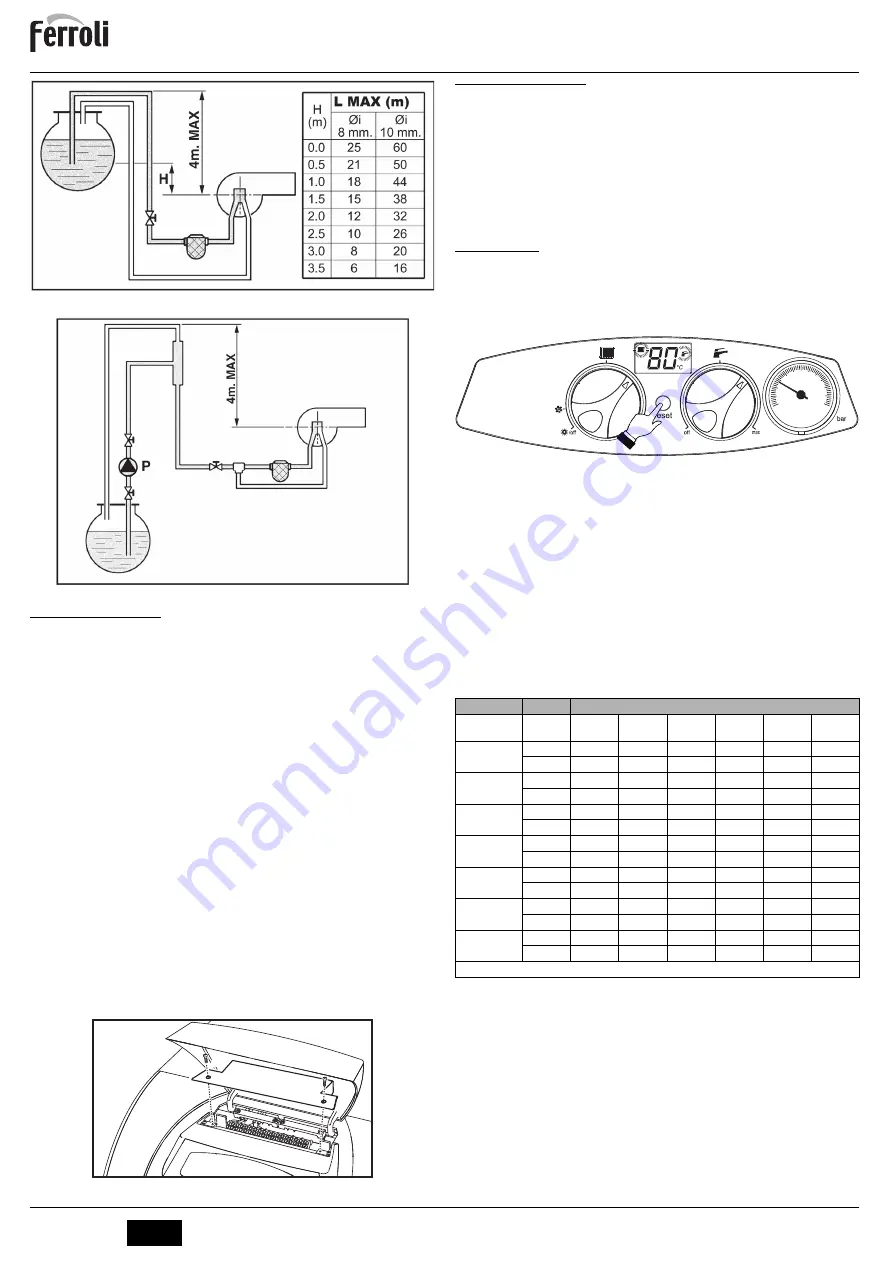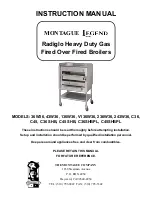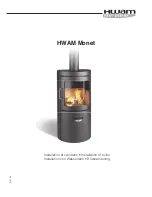
ATLAS ECO 30 SI UNIT
32
EN
cod. 3541Q551 - Rev. 00 - 09/2019
fig. 20 - Siphon feed
fig. 21 - Ring feed
3.5 Electrical connections
Connection to the electrical grid
B
The unit's electrical safety is only guaranteed when correctly connected to an
efficient earthing system executed according to current safety standards. Have
the efficiency and suitability of the earthing system checked by professionally
qualified personnel. The manufacturer is not responsible for any damage
caused by failure to earth the system. Also make sure that the electrical system
is adequate for the maximum power absorbed by the unit, as specified on the
boiler dataplate.
The boiler is prewired and provided with a Y-cable and plug for connection to the elec-
tricity line. The connections to the grid must be made with a permanent connection and
equipped with a bipolar switch whose contacts have a minimum opening of at least 3
mm, interposing fuses of max. 3A between the boiler and the line. It is important to re-
spect the polarities (LINE: brown wire / NEUTRAL: blue wire / EARTH: yellow-green
wire) in making connections to the electrical line. During installation or when changing
the power cable, the earth wire must be left 2 cm longer than the others.
B
The user must never change the unit's power cable. If the cable gets damaged,
switch off the unit and have it changed solely by professionally qualified person-
nel. If changing the electric power cable, use solely
“HAR H05 VV-F”
3x0.75
mm2 cable with a maximum outside diameter of 8 mm.
Room thermostat (optional)
B
IMPORTANT: THE ROOM THERMOSTAT MUST HAVE VOLTAGE-FREE
CONTACTS. CONNECTING 230 V TO THE ROOM THERMOSTAT TERMI-
NALS WILL PERMANENTLY DAMAGE THE ELECTRONIC BOARD.
When connecting time controls or a timer, do not take the power supply for
these devices from their breaking contacts Their power supply must be by
means of direct connection from the mains or with batteries, depending on the
kind of device.
Accessing the electrical terminal block
Undo the two screws
“A”
located on the top part of the control panel and remove the cover.
fig. 22 - Accessing the terminal board
3.6 Connection to the flue
The unit must be connected to a flue designed and built in compliance with current reg-
ulations. The pipe between the boiler and flue must be made from material suitable for
the purpose, i.e. heat and corrosion resistant. Ensure the seal at the joints and insulate
the entire pipe between boiler and flue, to prevent the formation of condensate.
4. SERVICE AND MAINTENANCE
All adjustment, conversion, commissioning and maintenance operations described be-
low must only be carried out by Qualified Personnel (meeting the professional technical
requirements prescribed by current regulations) such as those of the Local After-Sales
Technical Service.
FERROLI
declines any liability for damage and/or injury caused by unqualified and un-
authorised persons tampering with the unit.
4.1 Adjustments
TEST mode activation
Press the Reset button (detail 3 - fig. 1) 3 times in 3 seconds to activate the TEST mode.
The boiler lights irrespective of the heating or hot water demand.
The heating symbol (detail 5 - fig. 1) and DHW symbol (detail 6 - fig. 1) flash on the dis-
play.
fig. 23 - TEST Mode
To deactivate TEST mode, repeat the activation sequence.
The TEST mode is automatically disabled in any case after 15 minutes.
Burner adjustment
The burner is factory-set as given in table 2. The burner can be set to a different output
by acting on the pump pressure, nozzle, head adjustment, and air adjustment as per the
following paragraphs. In any case, the new adjusted output must fall within the boiler’s
nominal operating range. After making any adjustments, using a combustion analyser
check that the CO
2
content in the fumes is between 11% and 12%.
Nozzle flow rate table for oil
table 2 gives the oil flow rates (in kg/h) according to the change in pump pressure and
nozzles.
N.B.
- The values given below are only approximate, since nozzle flow rates can vary by
± 5%. Also, with burners having a preheater, the fuel flow rate decreases by about 10%.
Table. 2
A
A
Pump pressure (bar)
NOZZLE
G.P.H.
8
9
10
11
12
13
14
0.40
1.32
1.40
1.47
1.54
1.61
1.68
1.75
15.66
16.60
17.43
18.26
19.09
19.92
20.75
0.50
1.57
1.65
1.73
1.81
1.89
1.97
2.05
18.62
19.57
20.51
21.50
22.42
23.36
24.31
0.60
1.93
2.01
2.23
2.32
2.42
2.52
2.64
22.89
23.83
26.44
27.51
28.70
29.88
31.31
0.65
2.12
2.25
2.40
2.63
2.74
2.80
2.91
25.14
26.68
28.46
31.19
32.49
33.21
34.51
0.75
2.50
2.65
2.80
2.95
3.07
3.20
3.33
29.65
31.43
33.21
34.99
36.41
37.95
39.49
0.85
2.92
3.10
3.27
3.45
3.60
3.75
3.90
34.63
36.76
38.78
40.92
42.69
44.47
46.25
1.00
3.30
3.50
3.67
3.85
4.02
4.20
39.13
41.51
43.52
45.66
47.67
48.72
51.95
Flow rate at nozzle outlet in kg/h
0
120
60
80
100
40
20
x3
















































